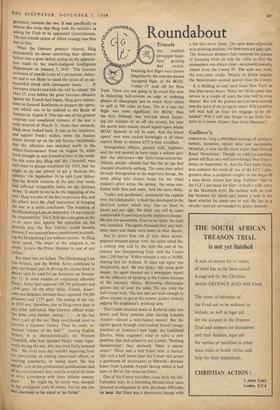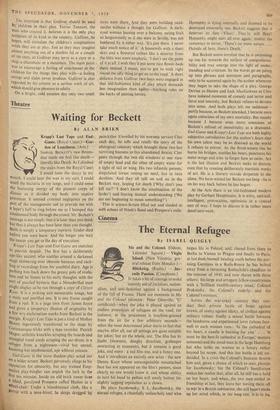Roundabout
Travels
THE exultant
newspaper head- lines greeting that record- breaking first flight were almost forgotten by the time the second inaugural flight of the BOAC Comet IV took off for New York. There was not going to be much fun now in balancing half-crowns on edge or ordering glasses of champagne just to watch them refuse to spill at 500 miles an hour. Yet in a way the flight was more significant for BOAC than the first. Nobody was worried about knock- ing ten minutes or so off the record, for now the guests were mainly travel agents upon whom BOAC depends to sell its seats. And the travel agents' eyes were cocked knowingly at all those aspects likely to interest £173-a-time travellers.
Immigration officers, ground staff, engineers and the rest seemed to have made a solemn pact that the old-timers—the forty-times-across-the- Atlantic people—should feel that the jet age had changed absolutely nothing. The same slow safari through Immigration to the departure lounge, the same piling into airport buses for the ritual minute's drive across the tarmac, the same con- fusion with hats and coats. And the same delay.
'Ladies and gentlemen,' announced the captain over the loudspeaker, 'a fault has developed in the electrical system which may take an hour to locate and put right. We think you will be more comfortable if you return to the departure lounge.' He was too pessimistic. Even as he spoke the fault was remedied. The agents fastened their seat belts once more and made stern notes in their diaries.
Just to prove how out of date those piston- engined museum-pieces were the cabin tilted like a sinking ship and by the time the end of the runway was disappearing from view the Comet was 1,200 feet up. Within minutes it was at 39,000, roaring fast for Iceland. At least one agent was temporarily deaf. He was lucky—the noise grew louder. An agent shouted out a newspaper report on the difficulty of sleeping in the Comet because of the uncanny silence. Brimming champagne glasses slid all over the table. No one tried the half-crown trick. The seat was not wide enough to allow anyone to get at his trouser pocket without jogging his neighbour's drinking arm.
The Comet touched down at Keflavik only two hours and forty minutes after leaving London Airport—almost a west-bound record ! But the agents gazed through rain-washed transit lounge windows at America's new hope, the Lockheed Electra, while engineers' tried to solve a new problem that had arisen- in our Comet. 'Nothing fundamental,' they declared. 'Only a starter motor.' Three and a half hours later it started. Ten and a half hours later the Comet slid across a panorama of skyscrapers at Idlewild—thirteen hours from London Airport during which it had been in the air for some ten hours.
One of the Comet travellers came back the old- fashioned way, in a bumbling Stratocruiser soon doomed to relegation. It only did about 300 miles an hour. But there Was a downstairs lounge with a bar that never closes. The seats were adjustable to a reclining position, the foot-rests are just right. The American designers had mastered the science of pumping fresh air into the cabin so that the atmosphere was always clear—an amenity notably absent from the Comet IV. The aisle was wide, the arm-room ample. Despite its piston engines the Stratocruiser seemed quieter than the Comet.
It is thrilling to roar back from New York in less than seven hours. When the DC8s come into service in a couple of years the time will be even shorter. But will the ground services have entered into the spirit of the jet age by then? Will travellers still wait half an hour for baggage to be off- loaded? Will it still take longer to get from Vic- toria to London Airport than from Shannon?
Gulliver's
LIMEHOUSE, long a cherished montage of seamen's bethels, laundries, opium dens and inscrutable Orientals, is now hardly more exotic than Oxford Road, Manchester. Though an odd,eye-catching poster still flaps on a wall advertising a New Year's dance on September 16. And the East India Dock area contains the result of one of the LCC's pro- gressive ideas, a sculpture roughly in the shape of a man about sixteen feet long. Gulliver—that is the LCC's pet name for him—is built a trifle awry in the Mooreish style. He reclines with an iron bar between his hands and boasts a hole in his head whether he needs one or net. He lies in a circular sand pit surrounded by grassy mounds.
Golden Journey
A Person From England and Other Travellers. By Fitzroy Maclean. (Jonathan Cape, 21s.) SOME years ago I read Eastern Approaches by Fitzroy Maclean and was fired with an irresistible desire to go at once to Central Asia. The fabulous names of Samarkand and Bokhara became almost an obsession. Eventually I packed a suitcase, took out a stiff insurance policy, and leaving my village in West Wales, I began the journeys that have taken me many times behind the Iron Curtain. It was fascinating to read, therefore, in Sir Fitzroy Maclean's new book, the tales of the men who had originally inspired him to make the Golden Jour- ney in the 1930s.
with varying degrees of success and with no great attention to any particular set of rules.'
The result is that Sir Fitzroy Maclean has written a book that is vintage John Buchan—with this difference, that it is about real people. There is adventure and courage and high surprise, told by a true story-teller. Reading it, I began to think again of the smells and the strumming music in the Moslem quarter of Samarkand, of the rich taste of khebab, of the cool stillness of Tamer- lane's tomb; and subconsciously I began thinking of packing that suitcase again and setting out for another glimpse of the disappearing Central Asia that will soon be replaced by Soviet industry and 'culture.' DESMOND DONNELLY



































 Previous page
Previous page